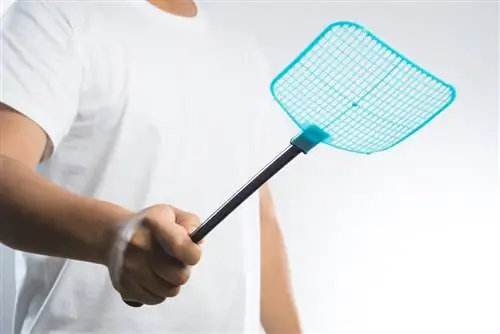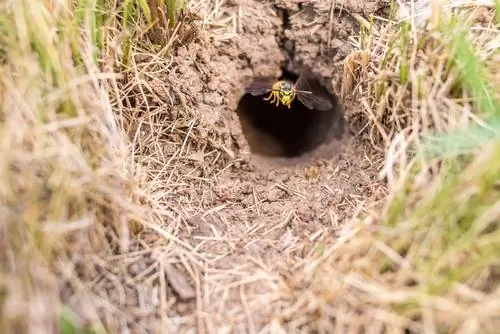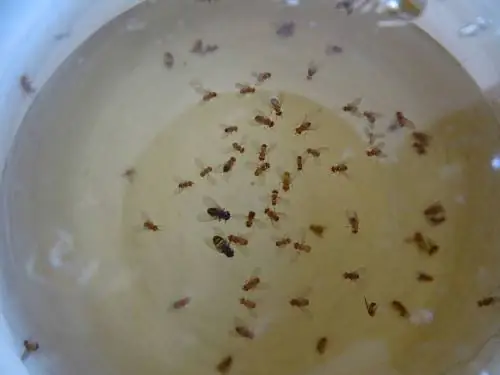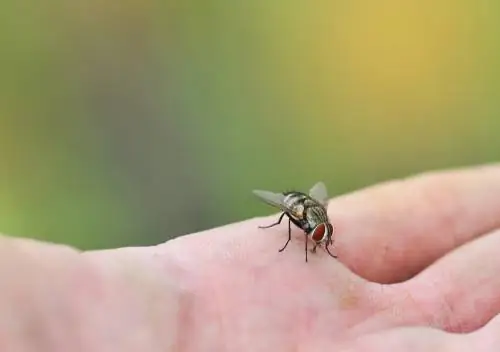- Author admin [email protected].
- Public 2023-12-26 14:17.
- Last modified 2025-01-23 11:22.
Many remedies prove to be ineffective when used. They don't seem to care about flies and there are reasons for that. The basis of successful deterrence is knowledge of the insects' sensory organs. They can perceive colors and smell aromas.

How can I get rid of flies without chemicals?
To repel flies naturally, use strongly scented plants such as lavender, catnip or bay leaf, vinegar traps, tea tree oil or essential oils on surfaces. Outdoors, ceiling fans, yellow boards or special landscaping can keep flies away.
These methods are ineffective
There are some remedies that have proven to be effective against flies under often unknown conditions. In most cases, it's not just one factor that contributes to the scare, but the combination of different points has effectively kept flies at a distance.
Water bag
A freezer bag filled with water is said to scare away flies. One theory is that the insects see their own reflection in the bag and therefore flee. The assumption that light reflections in the water confuse the flies sounds a little more plausible. In 2007 there was a study at North Carolina State University. Some rooms in an egg factory were provided with water bags, others were not. Mike Stringham placed white index cards in both rooms and then counted the fly droppings.
However, the results did not show any major differences. Both rooms were visited by almost the same number of flies. In some cases this method may still work. This observation is probably due to other factors and not to the water itself:
- clean apartment did not attract flies
- seasonally fluctuating occurrence
- other food sources nearby
- fewer flies flew due to suboptimal weather conditions
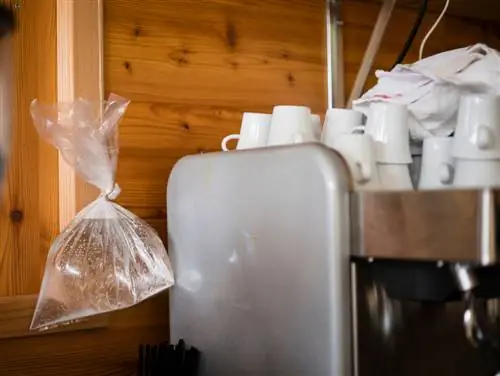
That bags filled with water repel flies is a rather controversial theory
Blue Windows
In old literature there are recommendations to paint windows of animal stables in blue paint. This measure is intended to deter flies so that cows and horses are spared from the pests. In fact, the insects are attracted to blue colors. They perceive a blue window in the middle of a red brick wall differently than people do. Experiments have shown that the insects prefer to settle on blue surfaces. Blue windows attract flies and keep them away from animals.
Excursus
The sense of sight of flies
Flies have compound eyes, whose numerous individual eyes enable a 360-degree view. Since the distance between vision and legs is extremely short, the insects can react in fractions of a second. Your eyes process many more images per second than the human eye. There are three point eyes in the forehead area between the compound eyes, which are responsible for the perception of contrasts.
In insects, the range of perception is shifted far into the ultraviolet range. They mainly perceive blue, while red tones are only recognizable as a dull gray. Unlike humans, flies can perceive striking patterns in the ultraviolet range. This is the reason why, to humans, white flowers appear conspicuous in the fly's eye.
How to get rid of flies?
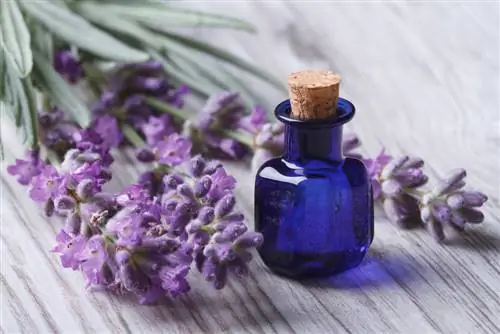
Flies don’t like the smell of lavender
It works differently to get rid of flies naturally without chemicals. The home remedies are effective in the home as long as they smell intensely. The deterrent effect is not the same everywhere, because the concentration of scents in the room decreases significantly as the distance to the source increases.
What flies like:
- Food sources: unpackaged food, half-full jars, crumbs, overripe and damaged fruit
- Trash can: open organic waste with a long shelf life
- Room conditions: calm conditions and warm temperatures
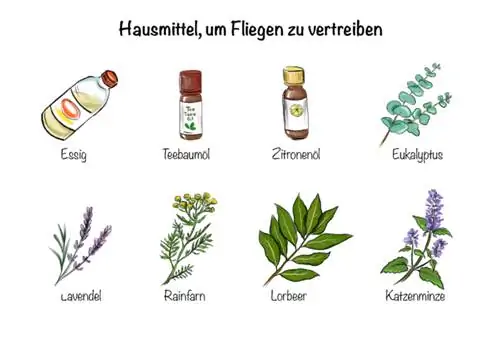
Vinegar
If you want to get rid of small flies that attack your fruit in the kitchen, you can use vinegar. Fill a bowl with water and a few drops of vinegar essence and cover the container with foil. Poke several holes in them and place the bowls next to the fruit plate. Fruit flies are attracted to the smell. They crawl into the trap and can't find a way out. To ensure that the trap does not lose its effectiveness, it should be replaced daily.
Tea tree oil
The intensely smelling essential oil is known for its antibacterial effects. Therefore, many insects such as mosquitoes and flies avoid environments that smell of tea tree oil. Put a few drops of oil in an aroma lamp and place it directly on the windowsill in front of the open window. The effect can be weakened by drafts.
Which plants repel flies?
Flies have numerous sensory cells on their antennae that can detect smells and cause a reaction. The antennae of the fly species respond to different smells. Meat flies are attracted to the smell of rotting meat. Many umbelliferous plants have an unpleasant smell for humans that magically attracts flies.
Such plants attract insects to the garden, while other flowers and herbs give off aromas that deter flies. These plants can prevent flies from entering your home thanks to their intense aromas. To do this, the measures must be repeated regularly, because essential oils are quickly volatile.
| effective ingredients | Application | helps against | |
|---|---|---|---|
| Lavender | Lavandin | Place the plant pot in the sun or spread scented oil | Houseflies |
| Eucalyptus | Cineol | lay out fresh leaves or apply scented oil | Mosquitoes and flies |
| tansy | Camphor, Borneol, Thujone | hang dried bouquets in the window | Whiteflies |
| Laurel | Cineol | Set up shallow containers with bay leaf oil | Houseflies |
| Catnip | Nepetalactone | Place the plant pot on the windowsill | Flies and mosquitoes |
| Lemon oil | Lime | Distribute slices | Houseflies |
video: Youtube

Get rid of annoying flies outdoors
The insects are magically attracted to the aromas of fresh steaks and marinades. Desserts and sweet fruits are also a feast for flies of all kinds. When grilling, joy quickly turns into displeasure. The terrace is preferred if there is a farm directly adjacent to the garden.
garbage bin
Organic and residual waste bins are true paradises for blowflies, which find abundant sources of food here. To prevent insects from getting into the interior, you should fit the lid with a rubber seal. After emptying the bin, clean it with vinegar water to remove any remaining residue. Cover the floor with newspaper and egg cartons. These materials absorb excess liquid. If you still discover maggots in the trash, you can kill them with ash, s alt or vinegar water.
Tip
Litter from the litter box works wonders because it absorbs moisture and prevents unpleasant smells.
Compost

Flies love compost piles
The compost heap is also a paradise for flies. Therefore, you have to make sure that the compost works properly. If there is good ventilation and sufficient moisture, hot rot occurs. Temperatures inside can be more than 60 degrees Celsius, which kills fly larvae. A little rock dust or pure ash helps against the maggots.
ceiling fan
Researchers at Jena University have discovered that hungry flies also fly against the wind. The insects show this behavior when the draft spreads pheromones or smells of food. Otherwise, flies avoid such winds. If you have the opportunity, you should install a ceiling fan above the dining table on the terrace and balcony. The gentle airflow keeps flies away from the table. A ceiling fan also provides air flow in the room, which drives away houseflies.
Flies avoid air currents and look for calm and warm places to stay.
Garden design and maintenance
Many umbelliferous plants have specialized in insect pollinators. They spread smells that are unpleasant to humans and attract flies. Create a natural strip in a remote corner of your garden with flowering plants that are attractive to flies. Keep the lawn around your patio short to create more hostile conditions.
These plants attract flies:
- Saxifraga: Moss Saxifrage, Jew's Beard, Nodule Saxifrage
- Spleenwort: Alternate-leaved spleenwort, opposite-leaved spleenwort
- Spurweed: Solstice Spurge
- Clematis: Upright clematis, Alpine clematis
- Heartleaf: Swamp Heartleaf
DIY fly repellent
When flies repeatedly settle on objects such as ceiling lamps or screens, they leave unsightly traces of excrement. There is often territorial behavior behind it and the houseflies try to mark their territory. Simple measures can help. The insects flying around can also be baited with a self-made trap.
Anti-fly cleaning products
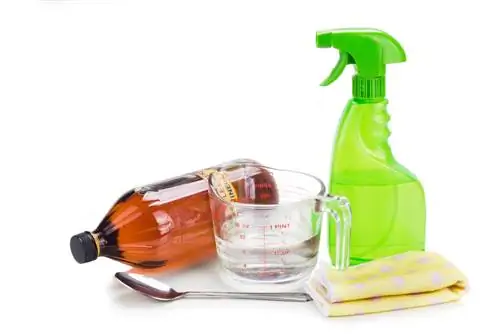
Anti fly repellent can be made from home remedies
It is not easy to drive flies out of the room with aromas. The concentrations are usually not so high that the insects automatically look for a way out. Homemade remedies made from essential oils prevent flies from settling on objects. Wipe surfaces regularly with an anti-fly cleaning product as the aromas disappear very quickly.
Ingredients:
- Neem, cedarwood, clove oil
- Lavender and Tea Tree Oil
- Oakmoss
- Fruit vinegar and water
Flytraps
Mix some molasses and cornmeal into a paste and place it on a plate. Place this on the terrace and balcony to keep away annoying flies while grilling. Simple sticky traps can be made from an attractant such as peanut butter or honey and glue. Alternatively, a mixture of ground pepper and syrup also works.
Craft instructions:
- Cut newspaper or blotting paper into strips
- Attach strips to a string
- Coat paper with attractant
- Knot the string at both ends and hang it up
- renew as soon as the attractant has dried out
Tip
The “Regulations for Druggists” from 1933 mentions a fly varnish that is made from ground rhizome powder of the tuba root and glucose syrup. When applied to paper, the agent attracts flies, which then stick to them.
Yellow boards
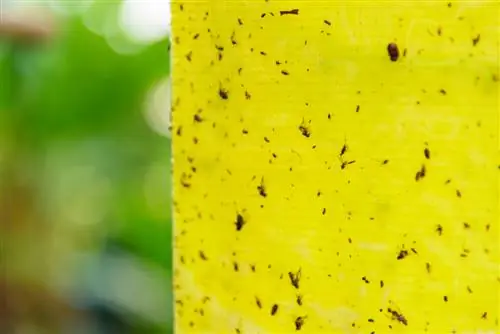
Yellow boards can also be made yourself
People see yellow flowers differently than flies. Because of their ability to reflect UV light differently, insects see yellow flowers as completely different colors. They can shine not only yellow but also purple or have a striking pattern. For this reason, yellow boards are preferred with a sweet attractant to catch flies:
- laminate yellow construction paper
- Mix sugar and water into a sticky mass
- Painting boards
Taking advantage of the herd instinct phenomenon
In the communications of the Swiss Entomological Society it was announced as early as 1967 that houseflies are subject to a herd instinct. Houseflies that sit still and eat attract more flies. The accumulations are becoming increasingly larger as more and more insects are made aware of the food source.
This herd instinct also worked in experiments in which food plates were equipped with dummy or dead flies. You can take advantage of this phenomenon with yellow boards. It may look unsightly, but the more flies there are on the paper, the more insects are attracted. The attractiveness is reduced if you clean the trap regularly.
Frequently asked questions
Are there ornamental plants that deter flies?
Strongly scented plants deter most flies and keep them away from homes and patios. Pelargoniums have proven to be good deterrent plants that keep flies away. You can choose different plants according to your taste and put them in a flower box, or combine different scents:
- Pelargonium crispum exudes lemon-like aromas
- Pelargonium fragans smells like pine trees
- Pelargonium tementosum provides a peppermint smell
How can I get rid of flies and mosquitoes?
The insects are deterred by essential oils. Catnip and eucalyptus have proven to be effective against flies and mosquitoes. You can cultivate catnip in pots and place it on the windowsill, or vaporize eucalyptus oil in a fragrance lamp. Since the essential oils are volatile, the effect wears off after a short time. You should therefore repeat the measure regularly.
How can I get rid of small flies?
Small flies on the ceiling can be fruit flies or fungus gnats. Attractant traps using vinegar or juices have proven effective on fruit flies. Fungus gnats usually come from potting soil and should be controlled with nematodes. To prevent such plagues from occurring in the first place, you should take preventive measures. Do not leave overripe fruit lying open and cover substrates in the plant pot with a layer of sand.
Where do houseflies lay eggs?
The females prefer organic material that is in an advanced stage of decomposition to lay their eggs. Garbage, compost, manure and food provide optimal conditions for the development of the larvae. In summer, a female can lay between 150 and 400 eggs per clutch. When the larvae hatch depends on the ambient temperatures. At 16 degrees Celsius they need 46 hours. The higher the thermometer rises, the faster the development occurs.
How long do houseflies live?
The service life depends heavily on the environmental conditions. Not only temperature but also humidity and food availability influence age. The optimal temperatures are between 20 and 25 degrees Celsius. If the thermometer drops below 15 degrees, immobilization occurs. Therefore, houseflies reach their highest population size in the summer months. They have a life expectancy of between six and 70 days. Females live longer than males, who usually live 28 days.
How fast are houseflies?
Flies can beat their wings about 180 to 330 times in one second. As a result, the insects reach a flight speed of 2.9 meters per second, which corresponds to around ten kilometers per hour. Houseflies are very agile and can react quickly to impending danger. This is possible because flies can process more images per second than the human eye.

